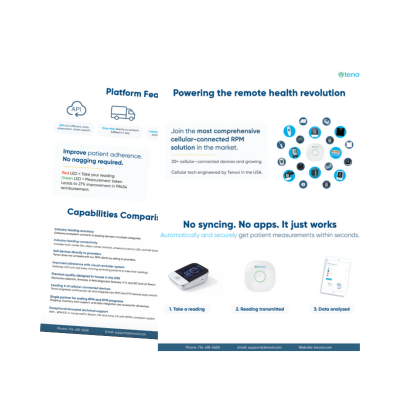Chronic care management (CCM) emphasizes care coordination and education, while remote patient monitoring (RPM) enables preventive care. Shifting from reactive to preventive care improves patient health outcomes, lowers costs, and increases reimbursement opportunities. Monitoring vitals at home between office visits is an example of preventive vs reactive healthcare. RPM helps detect risks early, reducing emergency visits and hospitalizations. Continuous data between appointments allows providers to act preventively rather than reactively.
In this article, you’ll learn how incorporating RPM into CCM programs can improve patient outcomes, increase reimbursement opportunities, and better support value-based care initiatives.
Preventive vs Reactive Healthcare: CCM and RPM, as a Complementary Approach
The Centers for Medicare & Medicaid Services (CMS) supports using both CCM and RPM to enhance care for patients with chronic conditions. Integrating remote patient data into CCM allows clinicians to gain health insights outside of clinical settings. The data collected can help assess whether care strategies are effective and if patient health goals are being achieved. Providers can continue to bill for CCM while adding RPM for a patient as long as the criteria for both programs are met. This approach demonstrates the shift toward preventive vs reactive healthcare by enabling real-time intervention and ongoing patient engagement.
Improved Patient Outcomes with RPM
Remote patient monitoring gives providers real-time patient data every time a patient takes a vital sign measurement. The ability to see consistent readings—such as blood pressure, weight, or glucose levels—enables clinicians to adjust treatment plans, preventively rather than waiting for the next appointment. Research shows that successful RPM programs can lower hospital readmission rates, improve medication adherence, and aid in disease management. These benefits highlight the advantages of preventive vs reactive healthcare, as early intervention can prevent complications and reduce healthcare costs.
RPM also aligns well with value-based care initiatives and advanced primary care services by reducing unnecessary hospitalizations and emergency department visits. Quality metrics can help improve provider performance in programs such as Medicare’s Quality Payment Program (QPP).
A study by Cardiac Solutions and MD Revolution found that remote patient monitoring led to a 50% reduction in 30-day hospital readmissions for heart patients. The study, which included 26,689 patients, showed that only 7% of RPM users were readmitted within 30 days compared to 15% of non-users. The benefits extended long-term, with RPM patients consistently showing lower readmission rates across 60, 90, 120, 180, and 365 days.
Cardiac readmissions cost an average of $15,000 per patient, and more than $52.4 billion annually is spent on hospital readmissions. Enrolling just 10 patients in RPM can prevent a single readmission. The study also reported that RPM is more effective than common therapies like statins for reducing cardiac-related hospitalizations.
Financial Incentives in Preventive vs Reactive Healthcare
CCM services typically reimburse providers on a per-patient, per-month basis, which can limit revenue potential. In contrast, RPM offers reimbursement per device and interaction, creating multiple monthly billing opportunities. According to CMS guidelines, providers can bill for the initial setup, device transmission, and monthly monitoring time, increasing reimbursement potential compared to CCM alone. This financial model reinforces the effectiveness of preventive vs reactive healthcare by incentivizing continuous patient engagement and preventive care.
Below is a breakdown of 2025 CPT codes and rates for remote patient monitoring:
- CPT 99453: Initial one-time setup and patient education. The average national rate is $19.73.
- CPT 99454: Device supply with daily recordings and transmission. The average national rate is $43.03.
- CPT 99457: First 20 minutes of clinician interaction. The average national rate is $47.88.
- CPT 99458: Additional 20 minutes of clinician time. The average national rate is $38.50.
Chronic care management CPT codes and reimbursement rates are as follows:
- CPT 99490: 20 minutes of non-face-to-face care coordination. The average national rate is $60.49.
- CPT 99491: 30 minutes of care management by a physician or qualified healthcare professional. The average national rate is $82.18.
- CPT 99439: Additional 20 minutes of non-face-to-face care. The average national rate is $45.94, if applicable.
- CPT 99437: Healthcare provider time for every additional 30 minutes. The average national rate is $57.58.
Complex CPT Codes
- CPT 99487: 60 cumulative minutes during 30 days of non-in-person consultation time. The average national rate is $133.66.
- CPT 99489: Additional 30 minutes with no limit. The average national rate is $70.52.
Rates are based on non-facility national averages and may vary by region.
Preventive vs Reactive Healthcare: Simplifying RPM Implementation
Providers may hesitate to adopt RPM due to perceived complexity. However, Tenovi simplifies the process with plug-and-play remote monitoring devices that eliminate technical barriers. With Tenovi’s Cellular Gateway, multiple devices used for chronic care can connect automatically, ensuring seamless data transmission to the Tenovi Cloud and onward to providers’ RPM platforms. This means no patient setup or Wi-Fi connectivity is required, reducing friction in adoption.
The Tenovi Gateway also serves as a visual reminder system to encourage measurement adherence. A red light reminds the patient to take a reading each morning, while a green light confirms the measurement was successfully transmitted to their doctor for a preventive vs reactive healthcare approach.
Additionally, Tenovi has an approved network of care services companies that providers can connect with to streamline the integration of RPM into their practice. These partnerships offer essential support services, patient engagement strategies, and operational guidance to help providers implement RPM effectively and ensure long-term success.
Understanding the Shift from CCM to RPM
RPM provides a valuable solution for healthcare providers facing increasing pressures to improve patient outcomes while maintaining financial sustainability. Adding remote monitoring to CCM programs creates a preventive vs reactive healthcare opportunity where providers can:
- Enhance patient care with real-time data insights.
- Support value-based care models by reducing preventable hospital visits.
- Increase reimbursements with multiple billing opportunities.
For providers already engaged in CCM, incorporating RPM is a logical next step with clinical and financial benefits. Contact a remote monitoring expert today to learn more about Tenovi’s seamless remote monitoring solutions.


